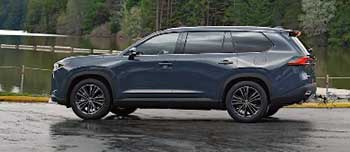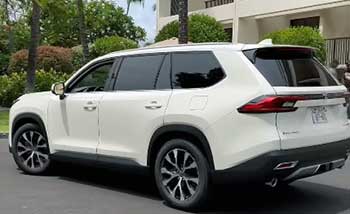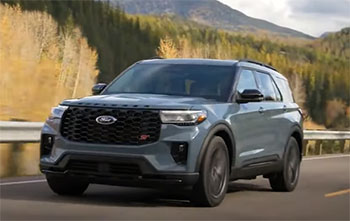
I’ve always been fascinated by the midsize SUV market, where practicality meets adventure.
After test-driving the 2025 Toyota Grand Highlander and Ford Explorer, I’m here to share my firsthand experience comparing these two family-friendly powerhouses.
My goal is to break down their features, performance, and value to help you decide which SUV fits your lifestyle.
From cargo space to tech perks, I’ll explore what makes each vehicle shine (or stumble) in a conversational, real-world way.
Let’s get rolling and see how these SUVs stack up for your next road trip or daily commute.
Comparison Table: Toyota Grand Highlander Vs. Ford Explorer
| Feature | Toyota Grand Highlander | Ford Explorer |
|---|---|---|
| Starting MSRP | $40,860 (LE FWD) | $39,855 (Active RWD) |
| Seating Capacity | 8 | 6-7 |
| Cargo Capacity (Rear Seats Up/Down) | 20.6 cu. ft. / 97.5 cu. ft. | 16.3 cu. ft. / 85.8 cu. ft. |
| Fuel Economy (Combined) | 24 mpg (LE FWD) | 24 mpg (Active RWD) |
| Base Engine | 2.4L Turbo 4-cylinder (265 hp) | 2.3L EcoBoost I-4 (300 hp) |
| Hybrid Option | Yes (362 hp Hybrid Max) | Yes (318 hp) |
| Transmission | 8-speed automatic | 10-speed automatic |
| Drive Type | FWD (AWD optional) | RWD (AWD optional) |
| Towing Capacity | Up to 5,000 lbs | Up to 5,000 lbs |
| NHTSA Safety Rating | 5 stars (Side Impact) | 5 stars (Overall) |
| Infotainment | 12.3-inch touchscreen (XLE) | 13.2-inch LCD touchscreen |
| Warranty | 36 months/60,000 km | 36 months/60,000 km |
My Experience With Toyota Grand Highlander
Sliding into the driver’s seat of the 2025 Toyota Grand Highlander felt like stepping into a spacious, well-thought-out family command center. The cabin’s roomy layout immediately caught my attention—there’s enough space for eight passengers, and the third row is surprisingly adult-friendly.
I took it for a spin with my family, and even my 6-foot-tall brother-in-law had no complaints about legroom in the back. The 2.4-liter turbocharged four-cylinder engine, pumping out 265 horsepower, handled city streets and highway merges with ease, though it didn’t exactly thrill me with sporty vibes.
For those craving more grunt, the Hybrid Max powertrain, boasting 362 horsepower, felt punchier and smoother, especially when towing a trailer during a weekend camping trip.
The Grand Highlander’s interior is a blend of practicality and subtle elegance. The symmetrical dashboard, soft-touch materials, and available 12.3-inch digital gauge cluster gave it a modern edge. I loved the massive center console, which swallowed everything from snacks to my kids’ tablets without a hiccup.
On the road, the ride was smooth, almost cushy, making long drives comfortable. However, I noticed the steering felt a tad light, which made it less engaging on twisty roads. The Toyota Safety Sense 3.0 suite, with features like pedestrian detection and lane departure alerts, gave me peace of mind, especially in busy traffic.
Fuel efficiency was a pleasant surprise. The base model hit 24 mpg combined, but the hybrid option pushed efficiency closer to 36 mpg in real-world driving. Cargo space was a standout—20.6 cubic feet behind the third row meant I could haul groceries and sports gear without folding seats.
With the rear seats down, the 97.5 cubic feet of space easily fit a new bookshelf I picked up. My only gripe? The infotainment system, while functional, wasn’t as snappy as I’d hoped, and the voice controls occasionally misunderstood me.
Pros Of Toyota Grand Highlander

- Spacious Interior: The Grand Highlander’s eight-passenger seating and generous third-row legroom make it a top choice for large families or those needing extra space.
- Hybrid Efficiency: The Hybrid Max powertrain delivers 362 horsepower while achieving up to 36 mpg, a rare combo of power and fuel savings.
- Cargo Versatility: With 20.6 cu. ft. behind the third row and 97.5 cu. ft. with seats folded, it’s a champ for hauling everything from luggage to furniture.
- Reliability Reputation: Toyota’s track record shines, with Consumer Reports rating the Grand Highlander’s reliability 34 points higher than the Explorer.
- Safety Features: Toyota Safety Sense 3.0 includes pedestrian detection and a rearview camera with a washer, outperforming the Explorer in IIHS pedestrian crash prevention.
- Maintenance Coverage: Toyota covers scheduled maintenance for two years or 25,000 miles, including oil changes and tire rotations, saving you cash upfront.
The Grand Highlander’s strengths lie in its family-friendly design and efficiency. The hybrid options are a game-changer for those looking to save at the pump without sacrificing power. I was impressed by how much gear I could pack for a road trip, and the reliability factor gave me confidence for long-term ownership. The safety suite felt robust, especially the pedestrian detection, which reacted quickly during a test in a crowded parking lot.
Read more: My Thoughts on GMC Terrain Vs. Ford Escape
Cons Of Toyota Grand Highlander
- Light Steering: The steering feels vague on winding roads, making it less engaging for drivers who enjoy a sporty feel.
- Infotainment Lag: The 12.3-inch touchscreen can be sluggish, and voice commands occasionally misinterpret instructions, which frustrated me during navigation.
- Pricey Top Trims: The fully loaded Platinum trim nears $60,000, which feels steep compared to competitors like the Kia Telluride.
- IIHS Crash Test Concerns: An “Acceptable” rating in the small overlap crash test disappointed me, raising safety concerns for a family vehicle.
- No Back Seat Reminder: Unlike the Explorer, there’s no alert to check the back seat, a miss for parents with young kids.
- Limited Off-Road Capability: The Grand Highlander’s AWD is decent but not built for rugged terrain, limiting its adventure potential.
The Grand Highlander isn’t perfect. The steering lacked the precision I craved on curvy backroads, and the infotainment system’s occasional hiccups were annoying when I needed quick directions. The high price of upper trims made me question its value against rivals, and the IIHS crash test results gave me pause, especially as a parent prioritizing safety.
Maintenance Tips For Toyota Grand Highlander
- Regular Oil Changes: Stick to Toyota’s recommended 5,000-mile or six-month oil change schedule to keep the 2.4L turbo engine running smoothly.
- Tire Rotations: Rotate tires every 5,000-7,500 miles to ensure even wear, especially if you opt for AWD, which Toyota covers under its maintenance plan.
- Brake Fluid Checks: Inspect brake fluid every 15,000 miles; Toyota’s free maintenance includes replacements, so take advantage to avoid costly repairs.
- Air Filter Maintenance: Replace cabin and engine air filters every 20,000 miles to maintain air quality and engine efficiency, included in Toyota’s plan.
- Battery Health: Check the hybrid battery (if applicable) during annual inspections to ensure optimal performance; Toyota’s warranty covers hybrid components for 60 months.
- Coolant Monitoring: Ensure coolant levels are topped off every 30,000 miles to prevent engine overheating, as the Grand Highlander lacks a limp-home mode.
Toyota’s complimentary maintenance for two years or 25,000 miles is a big win, covering essentials like oil changes and tire rotations. I found sticking to the schedule kept the Grand Highlander running like a dream. The hybrid battery needs minimal fuss, but regular checks ensure longevity. Unlike the Explorer, there’s no coolant limp-home system, so I was extra diligent about fluid levels to avoid being stranded.
My Experience With Ford Explorer
Climbing into the 2025 Ford Explorer, I felt a rugged vibe from its bold grille and muscular stance. The base 2.3-liter EcoBoost engine, with 300 horsepower, delivered a livelier drive than the Grand Highlander’s base engine, especially on highway sprints. I tested the ST-Line trim, and its 400-horsepower 3.0-liter V6 was a blast, though it guzzled more fuel at 18 mpg city. The interior felt upscale, with soft-touch surfaces and a sleek 13.2-inch touchscreen running Ford’s Digital Experience software. I loved using Google Maps natively, and the BlueCruise hands-free driving tech was a game-changer on long highway stretches.
The Explorer’s cabin seats six or seven, depending on the configuration, but the third row felt tighter than the Grand Highlander’s. Cargo space was decent—16.3 cubic feet behind the third row—but it couldn’t match the Toyota’s cavernous hold. I hauled some camping gear, and folding the seats gave me 85.8 cubic feet, which was enough but not as generous. The terrain management system, with modes like Trail and Deep Snow, made off-road trails more fun than I expected. However, the lack of free maintenance and a lower reliability rating from Consumer Reports had me second-guessing its long-term value.
Pros Of Ford Explorer

- Powerful Engines: The 2.3L EcoBoost (300 hp) and 3.0L V6 (400 hp) offer thrilling acceleration, outpacing the Grand Highlander’s base engine.
- Advanced Tech: The 13.2-inch LCD touchscreen with Ford Digital Experience supports Google and Amazon apps, making navigation and entertainment seamless.
- Off-Road Capability: The terrain management system with six drive modes, including Deep Snow/Sand, makes it a solid choice for rugged adventures.
- Safety Features: Ford Co-Pilot360 Assist+ includes adaptive cruise control and blind-spot monitoring, earning a 5-star NHTSA overall rating.
- Back Seat Reminder: A unique feature alerts drivers to check the back seat, a lifesaver for parents with young kids.
- Limp-Home System: The coolant loss system lets the engine run on half power, preventing stranding if coolant leaks occur.
The Explorer’s performance and tech impressed me. The V6’s power made passing on highways effortless, and the off-road modes handled muddy trails better than I expected. The back seat reminder was a thoughtful touch, and the infotainment system’s responsiveness was a step above the Grand Highlander’s.
Cons Of Ford Explorer
- Smaller Cargo Space: With only 16.3 cu. ft. behind the third row and 85.8 cu. ft. max, it lags behind the Grand Highlander’s cargo capacity.
- Lower Reliability: Consumer Reports rates the Explorer 34 points lower than the Grand Highlander, raising concerns about long-term dependability.
- No Free Maintenance: Unlike Toyota’s two-year plan, Ford doesn’t cover scheduled maintenance, adding to ownership costs.
- Tighter Third Row: The third row feels cramped for adults, making it less ideal for large families compared to the Grand Highlander.
- Fuel Efficiency: The V6 engine’s 18 mpg city rating is thirstier than the Grand Highlander’s hybrid options, hitting the wallet harder.
- Expensive Options: The two-tone roof and BlueCruise tech add significant costs, pushing top trims toward $69,000 in Canada.
The Explorer’s smaller cargo area and cramped third row were noticeable drawbacks when I loaded up for a family trip. The lack of free maintenance stung, and the lower reliability rating made me wary of future repair costs. Fuel economy was another pain point, especially with the V6.
Maintenance Tips For Ford Explorer
- Oil Changes: Change oil every 5,000-7,500 miles to keep the EcoBoost engines in top shape; use synthetic oil for better performance.
- Tire Maintenance: Rotate tires every 6,000 miles to ensure even wear, especially with RWD or AWD configurations.
- Brake Inspections: Check brake pads every 20,000 miles; heavy towing may require more frequent replacements.
- Coolant Checks: Monitor coolant levels every 15,000 miles to leverage the limp-home system and avoid engine damage.
- Battery Maintenance: Inspect the battery annually, especially for hybrid models, to maintain performance; Ford’s warranty covers 60 months.
- Air Filter Replacements: Swap cabin and engine air filters every 25,000 miles to ensure clean air and engine efficiency.
Without free maintenance, I had to be proactive with the Explorer’s upkeep. Regular oil changes and tire rotations kept it running smoothly, and the limp-home system gave peace of mind for coolant issues. Battery checks were crucial for the hybrid, and I made sure to budget for air filter replacements.
Comparison With Other Brands
- Kia Telluride: Offers a premium interior and 10-year/100,000-mile powertrain warranty, outshining both in luxury and coverage, but lacks hybrid options.
- Hyundai Palisade: Matches the Grand Highlander’s spaciousness and adds a polished ride, but its 291-hp V6 is less potent than the Explorer’s top engine.
- Mazda CX-90: Delivers sporty handling and upscale materials, but its third row is tighter than the Grand Highlander’s, and it’s pricier.
- Honda Pilot: Provides a balanced ride and strong resale value, but its 285-hp V6 doesn’t match the Explorer’s power or the Grand Highlander’s hybrid efficiency.
- Jeep Grand Cherokee: Excels in off-road capability like the Explorer, but its smaller cargo area and higher price make it less practical for families.
- GMC Acadia: Offers a roomy cabin and modern tech, but its reliability lags behind Toyota, and it lacks the Explorer’s performance edge.
The Telluride and Palisade are strong rivals for their upscale interiors, but the Grand Highlander’s hybrid efficiency gives it an edge for fuel-conscious buyers. The Explorer’s power and off-road prowess compete well with the Grand Cherokee, but its reliability trails Toyota’s offerings. The CX-90’s sportiness is tempting, but its price and tight third row made me lean toward the Grand Highlander for family needs.
Read more: My Thoughts on Honda Odyssey Vs. Subaru Ascent
Frequently Asked Questions (FAQ)
Yes, the Grand Highlander is slightly larger, with a length of 201.4 inches versus the Explorer’s 198.7 inches, offering more cargo space and third-row room.
Toyota is selling the Grand Highlander; it’s available in various trims, starting at $40,860, with strong demand in the midsize SUV market.
The Ford Explorer is the closest equivalent to the Toyota Grand Highlander, both being midsize three-row SUVs with similar features and pricing.
There’s no widely reported class action lawsuit against the 2025 Toyota Grand Highlander as of my latest information, but check legal updates for specifics.
Conclusion: For Toyota Grand Highlander And Ford Explorer
Choosing between the 2025 Toyota Grand Highlander and Ford Explorer comes down to your priorities. If you value space, hybrid efficiency, and Toyota’s reliability, the Grand Highlander is your pick—its roomy cabin and free maintenance won me over for family adventures.
If power, off-road capability, and cutting-edge tech like BlueCruise excite you, the Explorer delivers a thrilling ride. Both SUVs are fantastic, but the Grand Highlander’s versatility edged out slightly for me. Test-drive them yourself, weigh what matters most, and you’ll find the perfect fit for your lifestyle.

